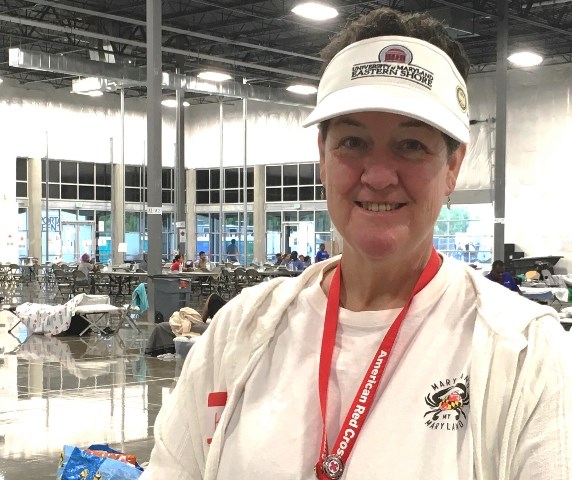
By Kate Kent
Thursday, September 28, 2017
Editor’s Note: UMES counselor Kate Kent used her professional training and experience to assist the American Red Cross as a volunteer assigned to shelters where Hurricane Harvey evacuees from the Gulf Coast relocated.
After officially being assigned by the American Red Cross to the Texas Hurricane Disaster detail, I suddenly thought, ‘what have I gotten myself into?’
I was told work conditions would be ‘hardship’ level and to pack things like a flashlight, and (I) had to qualify through a fitness health questionnaire.
I was given vague information about where to go once I landed in Texas and did not know when I left Delmarva where I was going to be assigned. Even though I arrived after 9 p.m., a local volunteer with a bright red vest was waiting in the baggage area to take several of us to a staff shelter hosted by a local Baptist Church.
The next day, I went to the Austin Convention Center, where the Red Cross had a headquarters set up to manage logistics and staffing for the disaster.
I ended up working in a medium shelter for a week in a middle school in Killeen, north of Austin and then at a “mega” shelter the second week.
I worked alongside nurses and a visiting doctor providing medical assistance and local groups that came in to make meals and feed people.
We had many elderly and handicapped people as well as families with small children.
One of my assignments was helping with mental health for the evacuees and trying to boost staff morale, including a 96-year-old woman applying for aid through FEMA.
An ‘up’ moment occurred on my second day, when we were able to bring people’s pets from various shelters and open up a pet shelter in the school so people could be with their animals.
Not long into my stay in Killeen, the Red Cross started shifting resources and getting set up in Florida to prepare for the approaching Hurricane Irma.
Meanwhile, other Killeen shelter volunteers and I focused on finding places closer to the up-rooted residents’ homes so we could better manage their recovery. My second week was spent in Texas’ capital city, Austin.
A local woman asked if she could make a pot of stew to bring. Mostly, however, the food came from corporate venders, like Chick-fil-A and H.E.B., a big grocery store chain based in San Antonio, The food was served by the local Salvation Army staff. One local company set up cable TV for the shelter so people had something to do in the day. A mobile phone company came and gave away free pre-paid phones.
The local mental health clinic sent workers to take evening shifts after their regular hours. Dell computers installed computer stations with an Internet connection for people to use. The Boys and Girls Clubs of Austin arranged activities for the youth, including a visit to a trampoline park and a baseball game.
The city of Austin provided buses for evacuees to go do chores like laundry and shopping.
Red Cross volunteers and evacuees came together to make the best out of a terrible situation. We worked with local, city and state officials to get people signed up for emergency aid and relief, but the process was slow.
The population was diverse and included people with health problems and mobility problems, and families with small children.
I was struck by the great humanity shown by most people. Hundreds of volunteers came to the shelters to offer things, from painting rocks with the kids, to daily day care, to haircuts for everyone, including staff.
Although I worked long hours, was constantly moving, and had to deal with some difficult situations, the experience left me with a positive impression because I felt glad to be part of something that restores one’s faith in the human race.

